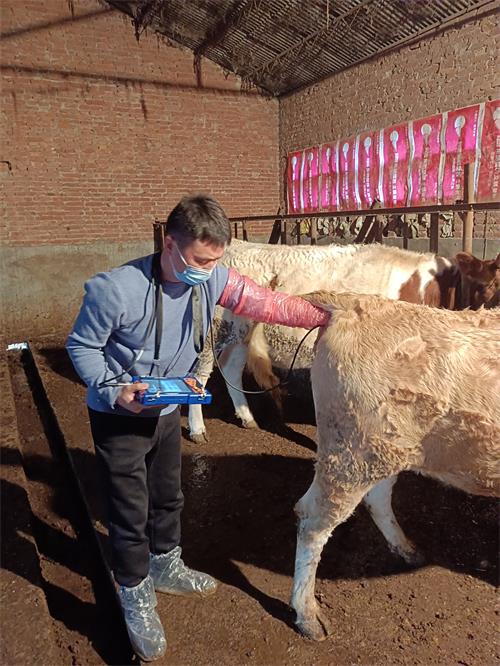La détection précoce et précise de la gestation est l’une des pratiques les plus importantes pour des opérations bovines rentables et efficaces. Whether you manage a small family farm or a large commercial beef or dairy operation, knowing the pregnancy status of your cows allows you to make informed decisions about nutrition, breeding schedules, herd management, and overall productivity.

Ultrasound scanning has become a gold standard for bovine pregnancy detection worldwide. It’s safe, fast, and provides more detailed reproductive insights than manual palpation or blood tests. Dans cet article, we’ll explore how to use ultrasound to determine if a cow is pregnant, when to scan, what to look for on the screen, and how this technology helps you reduce costs and increase reproductive efficiency.
Why Ultrasound for Pregnancy Detection in Cattle?
Ultrasound machines, also known as ultrasonography devices, use sound waves to create real-time images of the internal structures of animals. In pregnancy diagnosis, they allow the operator to visualize the uterus and detect a growing fetus as early as 25–30 days post-conception in cattle.
Compared to rectal palpation or blood-based pregnancy tests, ultrasound offers the following advantages:
-
Earlier and more accurate diagnosis
-
Ability to determine fetal age
-
Detection of twins or embryonic loss
-
Monitoring uterine health and ovarian structures
-
No waiting for lab results
When Is the Best Time to Perform an Ultrasound?
The optimal window for pregnancy diagnosis in cows using ultrasound is between 30 et 90 days after insemination or natural service. Scanning earlier than 28 days can result in false negatives due to embryo size, while scanning beyond 100 days offers less economic advantage, as open cows remain unproductive longer.
⧫ From 28 À 35 Jours: Detection of fluid-filled uterine horn and tiny embryo.
⧫ From 35 À 60 Jours: Embryo with heartbeat visible; easier to confirm viability.
⧫ From 60 À 90 Jours: Detailed fetal structures seen, sexing possible in some cases.

Understanding What You See on the Ultrasound Screen
Learning to interpret the ultrasound screen takes training and practice. The basic signs of pregnancy include:
-
Anechoic (black) fluid in the uterine horn (early sign of pregnancy)
-
Presence of a circular or bean-shaped embryo
-
Flickering motion indicating a heartbeat (confirms viability)
-
Later in gestation: identifiable body parts like the spine, limbs, or head
It’s important to scan both uterine horns and ovaries to rule out cysts, infection, or an anestrus condition.
Common Mistakes to Avoid
Even experienced operators can make mistakes that lead to misdiagnosis or missed pregnancies. Here are a few to watch out for:
-
Scanning too early (<28 Jours)
-
Misinterpreting uterine fluid for infection
-
Overlooking non-viable embryos
-
Relying on just one view or not scanning both horns
Training with an experienced ultrasound technician or veterinarian is strongly recommended before making breeding or culling decisions based on your scans.
Ultrasound Scanning Equipment and Probe Selection
Not all ultrasound machines are created equal. For bovine pregnancy detection, most practitioners use either a convex or linear rectal probe designed for transrectal use. The choice of probe depends on your breed type, operator experience, and whether you’re scanning standing or restrained animals.
Important ultrasound machine features for cattle pregnancy checks:
-
Imperméable, rugged build for farm conditions
-
Real-time imaging with clear resolution
-
Optional head-mounted displays for hands-free use
-
Rechargeable batteries for mobility
-
Freeze-frame and image storage capabilities

Economic Benefits of Ultrasound Pregnancy Detection
Culling non-productive cows, tightening calving intervals, and identifying twin pregnancies early are just some of the ways that ultrasound adds value. A study published in the Journal of Dairy Science found that using ultrasound for pregnancy diagnosis resulted in a 16% improvement in reproductive efficiency compared to manual palpation.
Other benefits include:
-
Reduced feed costs by identifying open cows sooner
-
Faster decision-making on rebreeding or selling
-
Improved herd reproductive records
-
Early detection of reproductive issues
Integrating Ultrasound into Your Reproductive Program
If you haven’t yet adopted ultrasound as a routine part of your reproductive management program, now is the time to consider it. Many farms partner with veterinary professionals to perform weekly or monthly herd checks. Some invest in portable ultrasound equipment and train staff in-house to reduce long-term service costs.
It’s critical to record all ultrasound findings accurately and pair the data with breeding and calving records to build a robust herd health history.
Conclusion
Ultrasound scanning is not just a tool for pregnancy confirmation — it’s a powerful herd management solution that drives efficiency, improves reproductive outcomes, and supports informed decision-making. With proper training and equipment, cattle producers can enhance profitability and animal welfare through earlier and more accurate pregnancy detection.
References and Sources:
-
Fricke, P.M. (2020). “Ultrasound Use in Bovine Reproduction: Opportunities and Limitations.” University of Wisconsin Extension. https://fyi.extension.wisc.edu/dairy/ultrasound-in-reproductive-management/
-
Lucy, M.C. (2001). “Reproductive Loss in High-Producing Dairy Cattle.” Theriogenology, 56(9), 1493–1503. https://www.sciencedirect.com/science/article/pii/S0093691X01006470
-
Lents, C.A. (2016). “Ultrasound use for reproductive management in beef cattle.” USDA ARS. https://www.ars.usda.gov/research/publications/publication/?seqNo115=320363
-
Dairy Herd Management (2017). “Improve pregnancy detection with ultrasound.” https://www.dairyherd.com/news/business/improve-pregnancy-detection-ultrasound